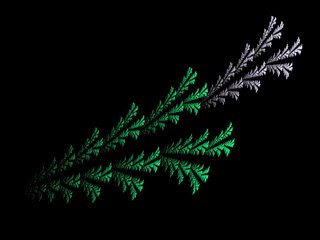Puzzled
 I probably was first introduced to fractals by the Winfract program sometime back in the early 1990's. I remember seeing color cycling for the first time and was hooked ever since.
I probably was first introduced to fractals by the Winfract program sometime back in the early 1990's. I remember seeing color cycling for the first time and was hooked ever since.Since this is my first post, I want to keep it mostly simple. The art and mathematic of creating fractals can become very complicated very quickly and can become overwhelming, time consuming, d&#! frustrating, and at the same time can be enjoyable as an escape from the stress of everyday life.
My first subject at orbit trap is about IFS fractals. I've been puzzled over this very simple / complicated formula for off and on several intervals of months over several years. I've seen the IFS in several programs, most recently being the apophysis program where it creates probably the most stunning images that I have ever seen. The formula for the IFS is quite simple, but the ways that the formula is transformed and the ways that the points are constructed into fractal art has been a great challenge to understand.
regards,
Stephen C. Ferguson




5 Comments:
With IFS, I could always sense a certain simplicity. Perhaps because of the angularity. Even the curves seemed made up of angular increments. Often, the result to me is tranquility and restfulness. The apophysis advances came into fashion after I'd withdrawn from the world of fractals. There are indeed some fine examples to be seen.
8/05/2006 10:34 AM
Kandid, an open-source project is one IFS program I really like. It adds "genetic" creativity to it by allowing you to combine IFS characteristics with different images by breeding them.
I've made stuff that looked like monuments made out of brick and also scenes that looked like something landscapes in winter. It seems to have a lot of capability and the images are often quite unique.
It's java, I think, but I didn't find it slow on my computer (450mhz).
I think the problem with Apophysis is that it's become so popular and easy to use that we see a lot of simple, default-style images out there. But there are also some very stunning ones too, just not so common.
8/05/2006 10:47 AM
To paraphrase a great American catchcry: software doesn't kill art, people kill art.
In general we take too much notice of all the crap out there. It's part of the identity problem that Tim mentioned in his reply to my post: we identify with all the crap and we choose to include it in our estimation of the artform. In fact, it should simply be ignored.
8/05/2006 11:18 PM
I'm not really impressed with 80% of what is created with any fractal software -- but that has much less to do with the software or its capabilities than it has to do with the goals and efforts of the person using it.
What I'm looking for in any work of art is the contribution of the artist's hand/eye/heart/spirit. And with fractals, that demands that the user goes way beyond relying on default settings, presets, and randomly generated batches. Sadly, not very many fractal enthusiasts appear to want to take the time to explore and learn on their own.
Many are seemingly happy with just about anything they create, and receive boatloads of enthusiastic support in online communities. With such easily attained praise, why bother working harder?
Some aspire to higher standards, but want to get there by tweaking others' images, or copying techniques that others have developed and then shared. There's a place for that when one is just starting out, but real creativity lies in going beyond what has gone before -- and that includes eschewing reliance on one's own trademark and highly-successful techniques in favor of blazing new trails. Very few seem to be willing to do that.
It's easy to spot the routine application of Difference merge mode, modulated iterations, lake or sphere transforms, imported images, etc.* The very first use of each of these was interesting, but unless subsequent uses incorporate them in new, unexpected, or unusual ways, the resulting images ~yawn~ don't tell me anything insightful about their creators. (*Those are, of course, UF terms and techniques because that's what I'm most familiar with, but each software has its own set of overused effects.)
8/06/2006 9:11 AM
Then there's the people who upload tons of stuff and never look at other people's pictures. Yahoo Fractal World had a few like that.
8/06/2006 5:56 PM
Post a Comment
<< Home